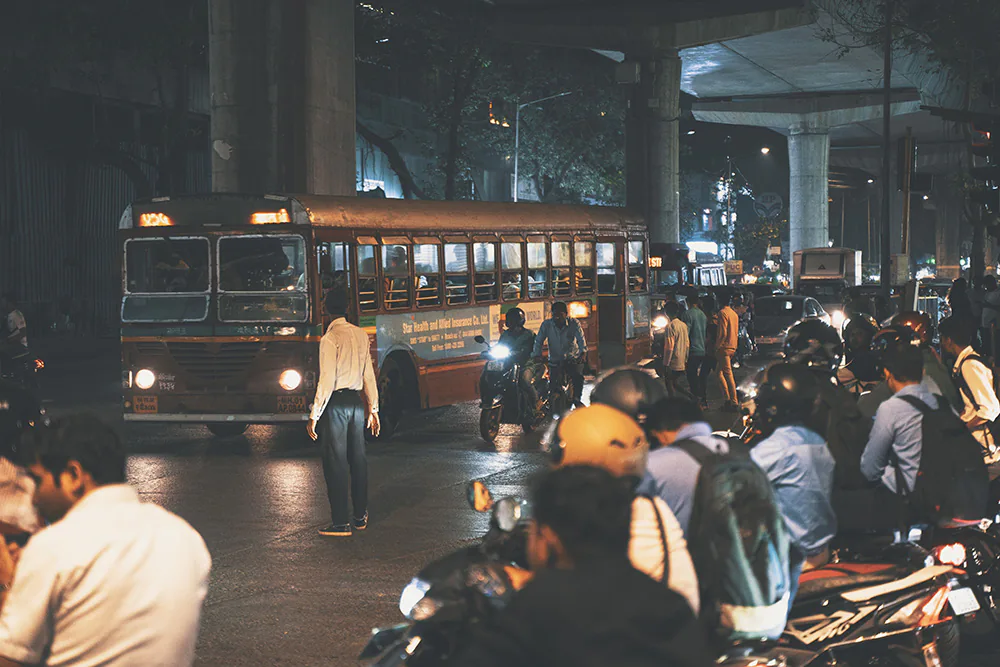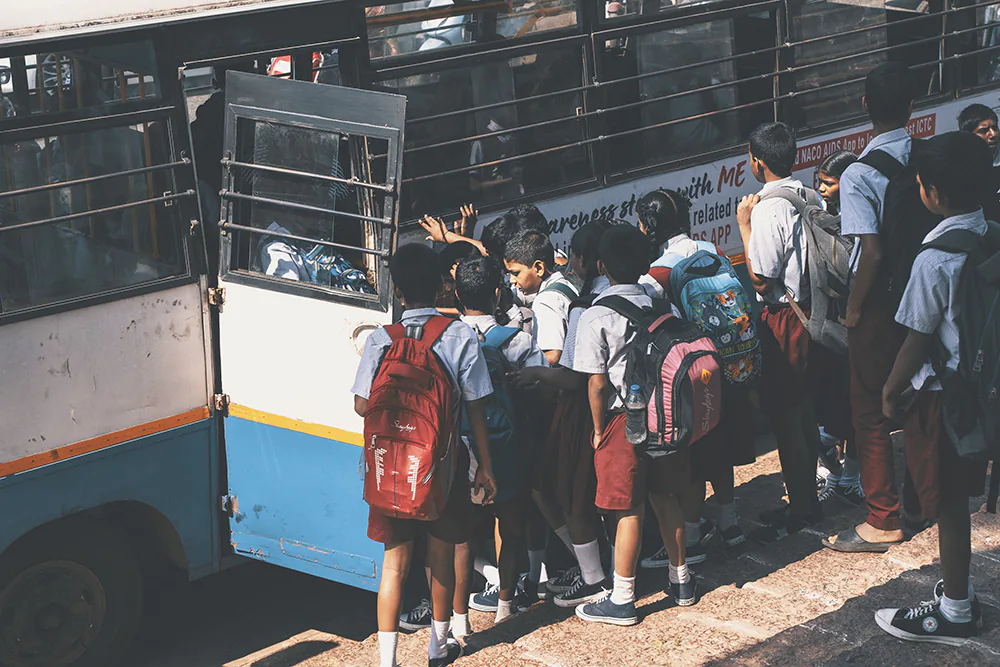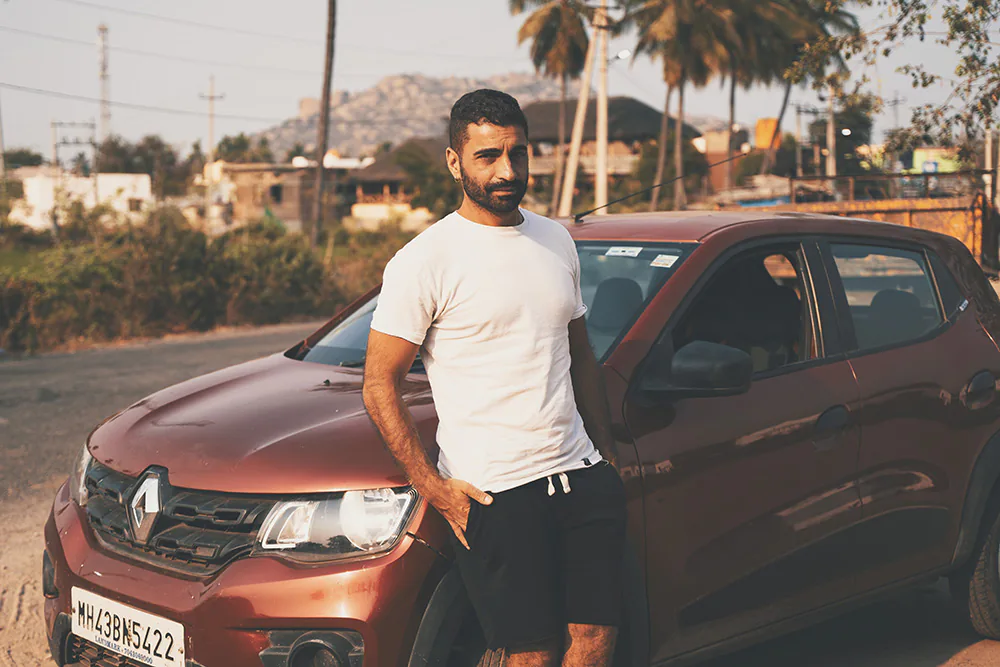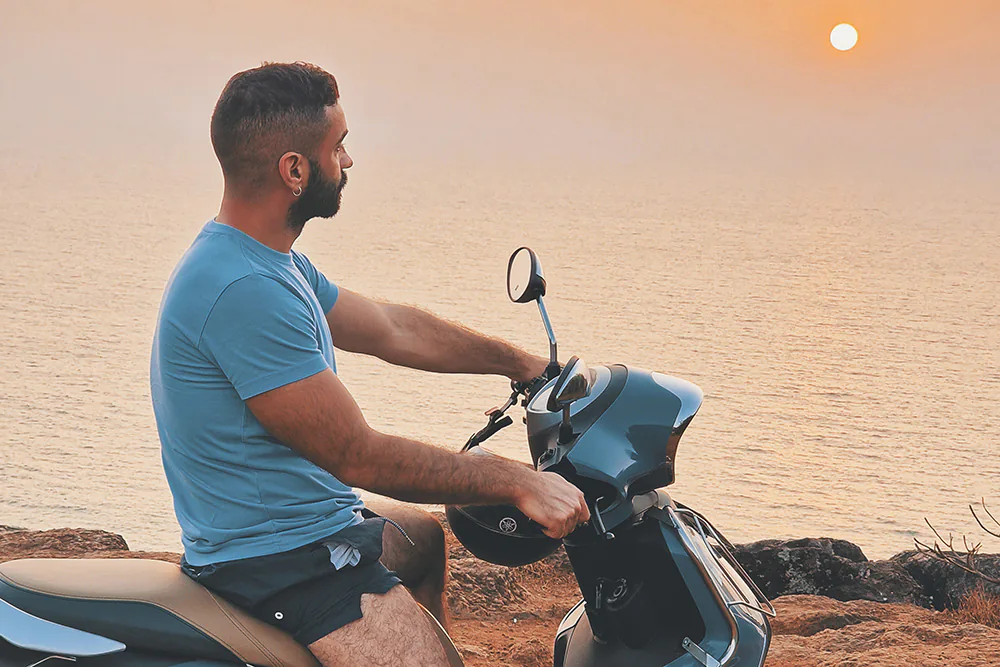After a one-month on the road trip in India and a total of about 4500 km traveled between cars and scooters in the states of Maharastra, Goa, Karnataka, Kerala, Tamil Nadu and the Andaman Islands, I can share with you the fruit of my experience and help you decide whether to face the trip to India behind the wheel or not.
The premises
Also in this case, after the driving experience in Morocco (which you can read about here) before leaving, I stocked up on articles and videos on driving in India and, once again, found myself hesitating at the idea of ??tackling another country's traffic. However, all my recent trips have greatly benefited from the freedom of movement that only a rental vehicle can give. Deciding if and when to leave, how far to travel, when and where to stop, even just to go to the bathroom, have a snack or take a picture are privileges that no other means of transport can give you.
Some passages of this article may scare you and dissuade you from the idea of ??renting a car and, perhaps, rightly so. However, I invite you to read it all. When you have read everything I have to tell you, you could decide otherwise!

A little stats
India is also known as The driver's Hell and the statistics on the subject (which you can read here) seem to confirm the adequacy of this epithet. A few hours after landing in Mumbai, walking in the area of ??the hotel where we were to stay overnight, Loretta and I witnessed a collision between a car and a scooter. Fortunately, as Mumbai's traffic is extremely congested, it is highly unlikely that accidents will cause who knows what damage to people or things. Again, that was the case. The thing that worried me at the idea that, only the next day, I would begin to be part of that traffic, was precisely the thought that I would find myself in that traffic jam, for who knows how long, deafened by the car horns and constantly worried about not collect dents on the bodywork of our temporary car.
The alternatives
The alternatives do not always offer great advantages, in addition to not having the responsibility of driving. In India, public transport, while relatively cheap, is often overcrowded and much slower than a car. The only valid alternative is represented by internal flights which, on the other hand, force you to travel between cities served by airports, leaving you to yourself again for any transfers to places that don't have any. The comforts of a car can also be had with rental with driver, a solution that frees you from liability but which obviously implies higher prices, as well as having to take into consideration the variables that another person can add to the trip. Personally, I haven't taken the latter hypothesis into consideration at all. A local driver can be a great advantage but imagine if, for a month of travel, you find yourself not having a great feeling with this person...

The mindset
As you may have imagined, even before I found myself behind the wheel, I was too saturated with worrying information, information that, on one hand, increases the level of anxiety but, on the other, did not make me take lightly situations that cannot be dealt with thereby. My previous experiences in the traffic of Rome, Amman and on the streets of Morocco (about which I had read the worst things, then contradicted by my experience) had strengthened my ego on the subject and acted as a counterweight to negative thoughts. Furthermore, I have to recognize in myself a certain ability to adapt which, in new and worrying situations, increases my concentration levels to the maximum, allowing me, even today, to get to tell you about my experiences. It follows that if you are a person who panics easily, if you suffer badly the pressure that other motorists can subject you to, it might be a good idea to give up and look for an alternative method of transport to the car.
I am, however, pretty sure that if you are even remotely considering driving in India, you do not fall into that group of people and the good news is that you are in the right article for you!
Renting a car
If you follow me, you know that, as much as I like the comforts of a car, I don't mind saving money. Before leaving for India, therefore, we sifted through dozens and dozens of car rental companies in Mumbai, asking for quotes and trying to bargain here and there (activities that I leave to the much more effective Loretta). In India, you won't find the classic big car rental companies you already know and trust but only renters who, at least to a non-Indian, will sound totally unfamiliar. On your side, however, as always, there is Google Maps with its very useful reviews. Discarding car rentals with zero reviews, those with very little feedback, as well as, of course, those with negative reviews, we find ourselves on the phone with the owner of Drive Yourself. After a careful display of the available vehicles, complete with photos sent on Whatsapp and a bit of bargaining, our choice fell on a Renault Kwid, the small car that, shortly thereafter, would have accompanied us for many kilometres. The renter, always on WhatsApp, sends us a long message containing the terms and conditions for the rental, to be read carefully. We understand that car hire does not provide full insurance coverage and having read what I had read about Indian traffic this was a bit perplexing. To resolve the issue, we thought of underwriting insurance with a third party for the entire month of our rental (at a price of around 150 euros on Rental Cover), just to be a little more relaxed. Having reached an agreement for the monthly rental at a price of 400 euros, we move on to the payment procedure. Trust in mankind, at this point, plays a fundamental role. The payment of the sum due, not mediated by any guarantor, took place by direct payment via Transfer Wise (other payment methods have given problems). If the charterer hadn't had the huge amount of positive reviews it has (to which mine has been added), I would hardly have relied on a payment method with so few guarantees.

For peace of mind (offline maps and/or local sim card)
The experience you get while traveling will depend on countless factors. In addition to the decisions you will make once abroad, the things you will do in advance, to prepare yourself, are of crucial importance. You are already doing one of these things: get informed.
In the world of telecommunications in which we live, staying out of the dynamics of geolocation is not a very attractive hypothesis. Once again, Google Maps comes to our aid. Definitely, you plan to buy a SIM Card once you arrive at your destination. Well! Can you consider yourself safe? No! A very useful thing you can do, even before leaving, is to download offline maps of the places you intend to visit. That way, you can be more confident that even if you don't have network coverage, you'll still know where to go!
To download offline maps:
In the world of telecommunications in which we live, staying out of the dynamics of geolocation is not a very attractive hypothesis. Once again, Google Maps comes to our aid. Definitely, you plan to buy a SIM Card once you arrive at your destination. Well! Can you consider yourself safe? No! A very useful thing you can do, even before leaving, is to download offline maps of the places you intend to visit. That way, you can be more confident that even if you don't have network coverage, you'll still know where to go!
To download offline maps:
- Open the Google Maps app while connected to the Internet
- Tap your profile picture, top right
- In the menu that has opened, touch the "offline maps" item
- Tap on the item “Select your map”
- Use your fingers to move around the map and to increase or decrease the portion of the map you want to download (there is a limit to the size of the map you can download. If you need to cover a larger area, repeat the procedure, downloading multiple offline maps, being careful to overlap each other a bit, to avoid leaving uncovered areas)
- Tap on the “Download” button
Let's take the car!
I'd like to tell you that, after reading this article, you won't be able to leave anything to chance. Unfortunately, that will not be the case. Once at the car rental, the renter reiterates the conditions to us. The unexpected, however, comes when the renter tells us that if we had been stopped at a checkpoint, we would have had to say that the car had been lent to us by a friend. The motivation, according to him, was to prevent the "potentially corrupt" policeman from asking us for a bribe. Attention, we have received a lot of useful information, in this phase, and also a sort of contract in which the obligations of both parties were defined, including the return of the deposit of an additional 240 euros which, in case of unforeseen events, would have been the basis to reimburse the car rental. The problem, relating to the "checkpoints" issue, is linked to how much we could, at that point, consider the rental to be "regular" and, consequently, in the event of unforeseen events, how much the insurance stipulated with Rental Cover would then have covered any damage . Was the corrupt police really the problem? As a result, our contract was in order, making our insurance valid as well? Or was it an excuse for a contract that didn't stand? Luckily, there was no way to find out, but had the latter guess been correct, the extra 150 euros spent on coverage would, in fact, have been thrown away.
But now we are at stake
We are accompanied to the car which is in excellent condition and clean. On the display, we read a total of 13300 km already traveled (therefore, a rather young car). We proceed to the usual filming of every single scratch or dent on the bodywork, so as not to be blamed, upon return, for damages not committed by us.
Trust in mankind is fine but if you have everything it takes to keep yourself safe, it would be foolish not to use it!
How to drive in India
On this subject, books could be written and, although I want to give you as much information as possible, I don't want to dust off the novel that, at a certain point, you would like to read again. I will therefore try to summarize.
As expected, city driving is a mystical experience. As an Italian, driving on the left (India was a British colony) with the steering wheel on the right was a detail I wasn't able to pay particular attention to. In fact, all my mental energies were allocated to the task of avoiding contact with the innumerable tuk tuk, driven by people evidently willing to do anything, in order to get their client to their destination a hundredth of a second earlier. The positive side of all this, as anticipated, is that driving in the British way could not be a problem (the only defaillance I have repeatedly had was to activate the wipers instead of the arrows and vice versa). In cities like Mumbai, the risk of getting bottled up is extremely high. Neutral to first gear and first to neutral can be your only activity, even for a full hour. For this reason, at least in cities, I have to admit that public transport is much better. By rail (metro and trains) it takes much less time to reach your destination; on the wheel, the times remain long but, at least, you can avoid the not remote possibility that you could dent the car. Arrived at the hotel, we parked the vehicle which we would only restart at dawn on the day we left the city (by leaving at dawn, we were able to have a smooth flow).
Highways are usually smooth but you can forget the idea of ??highway you have as an Italian or, in general, as a Westerner. In theory, of the three lanes, the left one would be reserved for bulky vehicles, trucks and buses that literally infest the streets of all of India. The central lane, on the other hand, would be reserved for cars and the right-hand one would be reserved for overtaking. Would be. Everything would be nice if it weren't for the fact that, in fact, everyone does what they want. Truck overruns truck overrunning coaches and, as if by magic, time and time again, you'll find yourself having all three lanes walled off by these giants as they slowly overtake each other. The tendency of large vehicles to stay in the fast lane forces motorists to repeatedly violate the rules of the road. The trend therefore becomes serpentine. Overtaking happens from the right, from the left and from the centre, i.e. wherever there is an opening. The only ones that respect the rule of keeping to the left are tractors and ox-drawn carts, which would also be a nice thing if it weren't for the non-negligible detail that these subjects, together with scooters and crazy pedestrians who want to cross, are on a highway...
As expected, city driving is a mystical experience. As an Italian, driving on the left (India was a British colony) with the steering wheel on the right was a detail I wasn't able to pay particular attention to. In fact, all my mental energies were allocated to the task of avoiding contact with the innumerable tuk tuk, driven by people evidently willing to do anything, in order to get their client to their destination a hundredth of a second earlier. The positive side of all this, as anticipated, is that driving in the British way could not be a problem (the only defaillance I have repeatedly had was to activate the wipers instead of the arrows and vice versa). In cities like Mumbai, the risk of getting bottled up is extremely high. Neutral to first gear and first to neutral can be your only activity, even for a full hour. For this reason, at least in cities, I have to admit that public transport is much better. By rail (metro and trains) it takes much less time to reach your destination; on the wheel, the times remain long but, at least, you can avoid the not remote possibility that you could dent the car. Arrived at the hotel, we parked the vehicle which we would only restart at dawn on the day we left the city (by leaving at dawn, we were able to have a smooth flow).
Highways are usually smooth but you can forget the idea of ??highway you have as an Italian or, in general, as a Westerner. In theory, of the three lanes, the left one would be reserved for bulky vehicles, trucks and buses that literally infest the streets of all of India. The central lane, on the other hand, would be reserved for cars and the right-hand one would be reserved for overtaking. Would be. Everything would be nice if it weren't for the fact that, in fact, everyone does what they want. Truck overruns truck overrunning coaches and, as if by magic, time and time again, you'll find yourself having all three lanes walled off by these giants as they slowly overtake each other. The tendency of large vehicles to stay in the fast lane forces motorists to repeatedly violate the rules of the road. The trend therefore becomes serpentine. Overtaking happens from the right, from the left and from the centre, i.e. wherever there is an opening. The only ones that respect the rule of keeping to the left are tractors and ox-drawn carts, which would also be a nice thing if it weren't for the non-negligible detail that these subjects, together with scooters and crazy pedestrians who want to cross, are on a highway...

Montain roads
Loretta and I love nature and, if we hadn't had a car available, most of the most beautiful places we've visited, for our tastes, would have been almost unreachable. The fact that we had a car which, I remember, was a simple utility vehicle, however, made them "barely reachable". In the mountains, the dual carriageway might make you wonder if you are hallucinating. Usually, there is one lane but there are two directions of travel. Consequently, if you want to go and enjoy the view of any place from above, pray that there are fewer people who take the opposite route than yours. Furthermore, it is good that you know that the further in you go, the higher you go, the less the road will be definable as a "road". You could end up on dirt roads with an exaggerated slope where you can't do anything but put into first gear and cross your fingers that nobody comes against you. It all sounds scary, and yet…
If you manage to get into the flow of Indian driving, if you abandon the pretension of driving as you have learned to do in your country and let yourself go with the flow, driving in India becomes a fun experience, a real video game in which you have to remember that you only have one life, and if you lose that, you don't restart from the last save point...
Seriously, I have to admit that, after a couple of days, driving in India became a real hoot. One of my main weaknesses when driving is sleep. In India, you will never be bored enough to fall asleep at the wheel so, at least on this one, you can sleep peacefully.
State of the roads and signs
The situation of the roads in India is very variable. When passing from one state to another, important differences can sometimes be noticed on the asphalted world. Goa, for example, could be considered a "motorist's paradise" among the places I've driven. In this state, road quality, signage, and law enforcement presence positively bucked the trend with others. One can see, for example, signs reminding that helmets are mandatory for those on two wheels or signs that dissuade, with puns or rhymes, from reckless driving (impatient on the road, patient in a hospital). Another element that I have seen only in the states of Karnataka and Kerala is the use of barriers as speed bumps. Positioned, in some more dangerous points, in order to reduce the width of the roadway, these barriers force traffic into a funnel which, consequently, will slow down. An element common to all roads is instead the incredible presence of classic speed bumps. These should, in fact, dissuade you from speed. In fact, they are so tall that if you go any faster than snail's pace you could tip over. Of course, it's an exaggeration to say that if you hit one of those while going 80, it's going to be hard not to smash everything there is to smash at the wheels' level. The state of the asphalt is also highly variable and motorways are no exception. India is in constant development and the roads well represent this condition. Many new carriageways are under construction and many others under reconstruction. This implies, at the moment, a series of detours due to works in progress that will take you from the wide carriageway to the single lane with holes.
Signage is not something to rely on when driving in India. Trust your navigator and you won't have any problems!
Signage is not something to rely on when driving in India. Trust your navigator and you won't have any problems!
Tolls and petrol stations
Remaining on the motorway, one cannot fail to mention tolls and the FastTag, an automatic payment system based on sensors. Talking to your renter about the presence of the FastTag in your car, before proceeding with the rental, will be an excellent idea. Anyone wishing to go through a toll booth without a FastTag will be forced to pay double the amount due. We are not talking about absurd figures but, doing a couple of calculations at the end of the trip, we estimated that we had spent about 75 euros more in tolls in a month, since our car was not "Fastagged".
The cost of petrol in India is considerably lower than in January/February 2023 in Europe, with a price per liter of around 1.10 euros (which is incredibly high for the income of many Indians). Petrol stations are very frequent but, depending on the destination (read "mountain"), they could become less frequent. Common sense, as always, is crucial. Don't wait for the last drop of fuel in the tank to refuel. Be careful! Furthermore, each distributor has a station for checking and correcting tire pressure. If you travel for a long time (or even at the beginning of the trip, to check that everything is ok) you should do a check from time to time.
The cost of petrol in India is considerably lower than in January/February 2023 in Europe, with a price per liter of around 1.10 euros (which is incredibly high for the income of many Indians). Petrol stations are very frequent but, depending on the destination (read "mountain"), they could become less frequent. Common sense, as always, is crucial. Don't wait for the last drop of fuel in the tank to refuel. Be careful! Furthermore, each distributor has a station for checking and correcting tire pressure. If you travel for a long time (or even at the beginning of the trip, to check that everything is ok) you should do a check from time to time.
Police
This paragraph should be titled “Police?” since it is almost doubtful that it exists on the streets of India. Only once, towards the end of the trip, were we asked to pull over by an agent. After asking our nationality and smiling at us, he turned his back on us. We had to ask, "Excuse me, but can we go?", before receiving a green light that he had taken for granted.
The horn
Here we are at the great protagonist of Indian traffic: the horn. In India, honking shouldn't make you feel anxious or pressured. In India, the horn is a tic that many people have when driving. Initially, you may think that by using the horn, some people are trying to urge you to go faster or move, and sometimes this could be the case. In most cases, however, the real message of the horn is: friend, I'm here beside/behind you, be aware of my presence. Other times, however, as I said, the horn will only be the manifestation of a tic. You will see cars and tuk tuks passing in traffic-free streets but honking the horn, you will see situations in which you evidently are forced to stand still, and the case is not invented, while a large school group is crossing and the guy behind he'll start trumpeting as to whether running over a dozen children is really an alternative to waiting. In these situations you have to constantly remind yourself that this is how it works in India and the horn doesn't have the annoying connotation it probably has in your country.
Problems and assistance
In our nearly flawless road trip, there was no shortage of problems. On the other hand, a month is long and 4500 km is a lot. For us, the problems have been related to the car battery. After a coffee break in a café, the car no longer gave any signs of life. Here the mindset plays the most important role. Whining is useless and, basically, the question to ask yourself is “what would I do, if I were in my country, to solve this problem?” because, coincidentally, the answer you give yourself will be the solution to your current problem! So, fish your smartphone out of your pocket, go to Google Maps and look for the nearest car technician! If it's close enough, take a walk! Otherwise, you can always call (because you made the local Sim, right?). In our case, we made the phone call but English is not the most common in those parts and, even when it is spoken, it is difficult to understand for those not accustomed to the Indian inflection. From a problem comes a solution. The parking attendant of the cafe where we were stopped, well aware of our problem, since he could see it, although he didn't speak English, was our link with a mechanic who, in less than 10 minutes, got to us, solving the problem at a cost of just over 3 euros. The real problem of our car, however, was the small size of the battery, compared to its housing (it was not the right battery for that car). Because of this, each vibration generated the movement of the battery which, subjected to stimuli such as the bumps mentioned above, at a certain point gave the negative cable one too much tug, breaking it and leaving us stranded again. Some workers in the vicinity momentarily left the construction site, seeing us with the car broken down and, having pointed out the problem, they equipped themselves with tools and jammed the cable, temporarily, so that it would come back into contact with the battery and allow us, at least, to get to the nearest mechanic.
We set off, thanking them, but, unfortunately, the temporary solution gave way again. The procedure is the same: Google Maps and a stroll. Long story short, a staff of 5 took care of our problem, solving it (replacing the cable) and, to top it off, adding oil to the engine (which was a bit low), all for a price of around 9 euros . The problem of the too small and mobile battery, however, remained (we could have changed it but we didn't feel like spending that money). But where there's an open mind there's always a solution. We bought some electrical tape and taped the battery around other parts of the car. A shepherd, noticing our movements with the hood open, approached and reinforced our work with a rope that solved the problem definitively, for the following 20 days.

drive a scooter, in India
One of the solutions most appreciated by tourists, for short journeys in India, is certainly the rental of two wheelers, motorcycles or scooters. Loretta and I did it on two occasions. The first was in Goa, a place of beaches and entertainment, and it happened on a pure whim, just to enjoy the wind in our faces on the journeys between one beach and another while in our home country we suffered the harshness of winter . The second time, however, was out of necessity, on the island of Havelock, in the Andamans, where, for a week, we were forced to leave our car getting dusty at the Chennai airport. On this island you could always rely on public transport but adjusting to schedules can become a hassle as tuk tuks, used several times a day, end up costing more than a day's rental scooter. Prices are very low. In the first case, we paid just over 5 euros for one day for an almost brand new scooter. In the second case, just over 4 euros a day for a scooter that was much more experienced but, no less functional. Of the approximately 4500 km traveled in India, about 150 were on the saddle of a scooter. The two wheels, when you decide to travel around India using internal flights, could be an excellent solution for small trips in and from the cities served by airports!
Return of the car and final considerations
At the end of our month around South India, we find ourselves in Mumbai, for the closure of the loop and for the return of the car. After having washed the vehicle, in respect of the renter and to preserve part of the deposit which, otherwise, would have been, rightly, partially retained for this service (and it is always better to have control of how much we spend), we return the car and see the deposit returned, reduced by a lump sum for the extra kilometers traveled (3500 were included in the price, we made 1000 more) but acknowledging that the expenses incurred for car maintenance were reimbursed. After the procedure, nobody will take it away from you a sigh of relief, when everything went well, even though driving in India no longer caused anxiety. That is, however, the moment in which you tell yourself that everything went well, it is the moment in which you see yourself grown up, in which you know that you have stepped out of your comfort zone and that you have rocked, despite all the premises. This is that moment in which you thank that vehicle for all the magnificent places it has brought you to reach, for the freedom it has been able to give you and for being a further means, perhaps the strongest of all, to make you experience, even more intensely, the culture of a place, from the chaos of car horns to the immense availability of passers-by who are always ready to give you a hand. This is how Loretta and I traveled. You can do better if you can and want to. You can decide to spend more and have more guarantees from an insurance point of view, you can decide to rent an off-road vehicle to have an easier life on bad roads, etc. In my case, the desire to travel fights with my substantial status of "Poor" (I speak for myself) and with a little courage (read "recklessness", "resourcefulness", "madness", you name it).

Ultimately, we were super-satisfied with our trip and would do it all again the same way! Before leaving you to your considerations, there is one last thought that I would like to share with you. After you've read it, it may seem obvious to you, evaluate yourself.
The idea that Indian motorists get, before going to India, reading in blogs, is that of bloodthirsty madmen who don't even care about their lives, let alone yours! The obviousness I was telling you about lies in the simple observation that, although many believe in reincarnation, Indians also care about their skin and prefer their vehicles without dents. It was while I was in India that, like an epiphany, this thought popped into my mind: they don't want to die either! Fear for one's own skin sometimes makes one unable to see the most obvious things...
Remember, this is the result of my experience. It's just one more point of reference to help you decide how to approach your trip to India. Obviously, your experience will be different, better or worse, based on the innumerable factors at play.
I hope I have inspired you. If the article left you anything, Likes, shares and comments are greatly appreciated. If you want to read more similar content, subscribe to the NEWSLETTER and/or follow me on INSTAGRAM!


